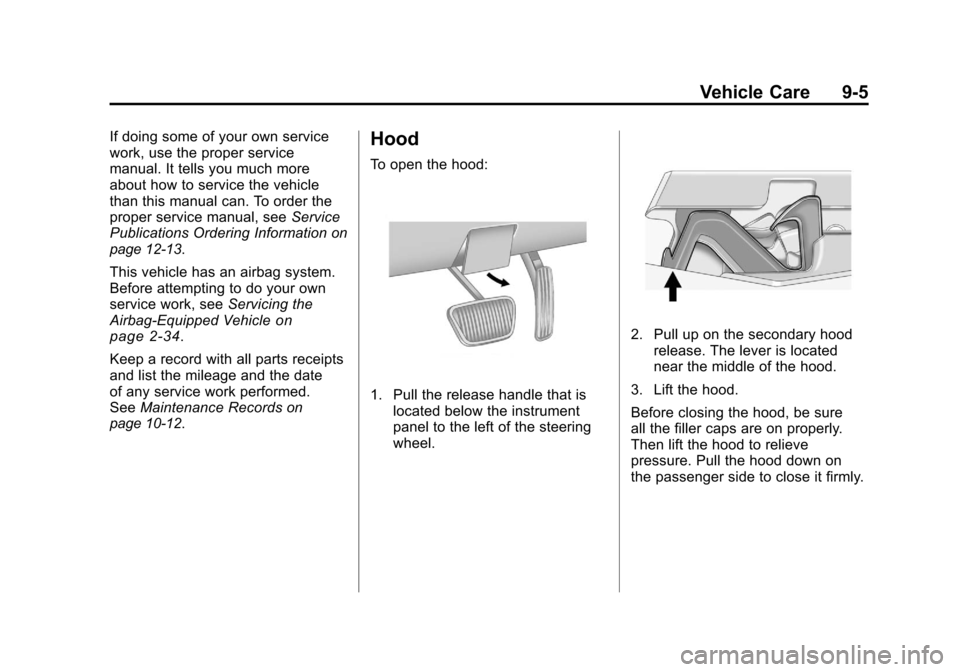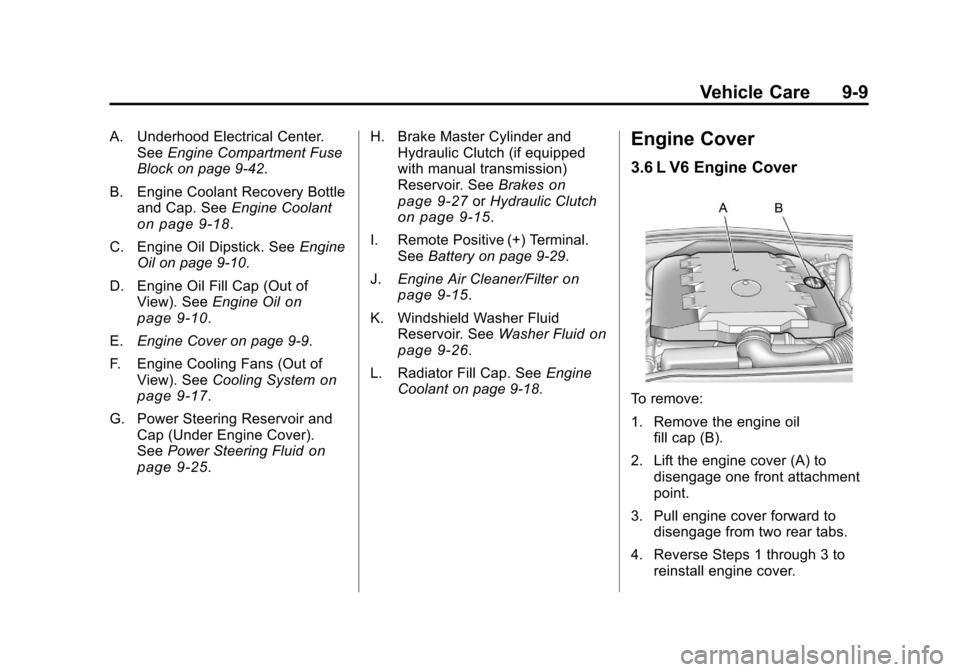2010 CHEVROLET CAMARO steering
[x] Cancel search: steeringPage 227 of 378

Black plate (51,1)Chevrolet Camaro Owner Manual - 2010
Driving and Operating 8-51
Backing Up
Hold the bottom of the steering
wheel with one hand. Then, to
move the trailer to the left, move
that hand to the left. To move the
trailer to the right, move your hand
to the right. Always back up slowly
and, if possible, have someone
guide you.
Making Turns
Notice:Making very sharp turns
while trailering could cause the
trailer to come in contact with the
vehicle. The vehicle could be
damaged. Avoid making very
sharp turns while trailering.
When turning with a trailer,
make wider turns than normal.
Do this so the trailer won't strike
soft shoulders, curbs, road signs,
trees or other objects. Avoid jerky or
sudden maneuvers. Signal well in
advance.
Turn Signals When Towing a
Trailer
The arrows on the instrument panel
flash whenever signaling a turn or
lane change. Properly hooked up,
the trailer lamps also flash, telling
other drivers the vehicle is turning,
changing lanes or stopping.
When towing a trailer, the arrows on
the instrument panel flash for turns
even if the bulbs on the trailer are
burned out. For this reason you
may think other drivers are seeing
the signal when they are not. It is
important to check occasionally to
be sure the trailer bulbs are still
working.
Driving On Grades
Reduce speed and shift to a
lower gear before starting down
a long or steep downgrade. If the
transmission is not shifted down,
the brakes might have to be used
so much that they would get hot
and no longer work well.
Vehicles with automatic
transmissions can tow in
D (Drive) but M (Manual Mode) is
recommended. See “Manual Mode”
in Automatic Transmission
on
page 8‑26for more information.
Use a lower gear if the transmission
shifts too often. For vehicles with a
manual transmission, it is better not
to use the highest gear.
Page 233 of 378

Black plate (1,1)Chevrolet Camaro Owner Manual - 2010
Vehicle Care 9-1
Vehicle Care
General Information
General Information . . . . . . . . . . . 9-3
California Proposition65 Warning . . . . . . . . . . . . . . . . . . 9-3
California Perchlorate Materials Requirements . . . . . . . . . . . . . . . 9-3
Accessories and Modifications . . . . . . . . . . . . . . . . 9-4
Vehicle Checks
Doing Your OwnService Work . . . . . . . . . . . . . . . . 9-4
Hood . . . . . . . . . . . . . . . . . . . . . . . . . . 9-5
Engine Compartment Overview . . . . . . . . . . . . . . . . . . . . 9-6
Engine Cover . . . . . . . . . . . . . . . . . 9-9
Engine Oil . . . . . . . . . . . . . . . . . . . 9-10
Engine Oil Life System . . . . . . 9-13
Automatic Transmission Fluid . . . . . . . . . . . . . . . . . . . . . . . 9-14 Manual Transmission
Fluid . . . . . . . . . . . . . . . . . . . . . . . 9-14
Hydraulic Clutch . . . . . . . . . . . . . 9-15
Engine Air Cleaner/Filter . . . . . 9-15
Cooling System . . . . . . . . . . . . . . 9-17
Engine Coolant . . . . . . . . . . . . . . 9-18
Engine Overheating . . . . . . . . . 9-23
Power Steering Fluid . . . . . . . . 9-25
Washer Fluid . . . . . . . . . . . . . . . . 9-26
Brakes . . . . . . . . . . . . . . . . . . . . . . . 9-27
Brake Fluid . . . . . . . . . . . . . . . . . . 9-28
Battery . . . . . . . . . . . . . . . . . . . . . . . 9-29
Rear Axle . . . . . . . . . . . . . . . . . . . . 9-29
Starter Switch Check . . . . . . . . 9-31
Automatic Transmission Shift Lock Control System
Check . . . . . . . . . . . . . . . . . . . . . . 9-31
Ignition Transmission Lock Check . . . . . . . . . . . . . . . . . . . . . . 9-32
Park Brake and P (Park) Mechanism Check . . . . . . . . . 9-32
Wiper Blade Replacement . . . 9-32
Headlamp Aiming
Headlamp Aiming . . . . . . . . . . . . 9-33
Bulb Replacement
Bulb Replacement . . . . . . . . . . . 9-36
Halogen Bulbs . . . . . . . . . . . . . . . 9-36
High Intensity Discharge (HID) Lighting . . . . . . . . . . . . . . . . . . . . 9-36
Headlamps, Front Turn Signal and Parking Lamps (Base
Vehicle) . . . . . . . . . . . . . . . . . . . . 9-37
Headlamps, Front Turn Signal and Parking Lamps
(Up-Level Vehicle) . . . . . . . . . . 9-38
Daytime Running Lamps (DRL) . . . . . . . . . . . . . . . 9-39
Fog Lamps . . . . . . . . . . . . . . . . . . 9-40
Taillamps, Turn Signal, and Stoplamps . . . . . . . . . . . . . . . . . . 9-40
License Plate Lamp . . . . . . . . . . 9-41
Replacement Bulbs . . . . . . . . . . 9-41
Page 237 of 378

Black plate (5,1)Chevrolet Camaro Owner Manual - 2010
Vehicle Care 9-5
If doing some of your own service
work, use the proper service
manual. It tells you much more
about how to service the vehicle
than this manual can. To order the
proper service manual, seeService
Publications Ordering Information
on
page 12‑13.
This vehicle has an airbag system.
Before attempting to do your own
service work, see Servicing the
Airbag-Equipped Vehicle
on
page 2‑34.
Keep a record with all parts receipts
and list the mileage and the date
of any service work performed.
See Maintenance Records
on
page 10‑12.
Hood
To open the hood:
1. Pull the release handle that is located below the instrument
panel to the left of the steering
wheel.
2. Pull up on the secondary hoodrelease. The lever is located
near the middle of the hood.
3. Lift the hood.
Before closing the hood, be sure
all the filler caps are on properly.
Then lift the hood to relieve
pressure. Pull the hood down on
the passenger side to close it firmly.
Page 239 of 378

Black plate (7,1)Chevrolet Camaro Owner Manual - 2010
Vehicle Care 9-7
A. Underhood Electrical Center.See Engine Compartment Fuse
Block on page 9‑42.
B. Engine Coolant Recovery Bottle and Cap. See Engine Coolant
on page 9‑18.
C. Engine Cover on page 9‑9.
D. Engine Cooling Fans (Out of View). See Cooling System
on
page 9‑17.
E. Radiator Fill Cap (Out of View). See Engine Coolant
on
page 9‑18.
F. Power Steering Reservoir and Cap (Out of View). See Power
Steering Fluid on page 9‑25.
G. Engine Oil Fill Cap. See Engine
Oil on page 9‑10. H. Engine Oil Dipstick (Out of
View). See Engine Oil
on
page 9‑10.
I. Brake Master Cylinder and Hydraulic Clutch (if equipped
with manual transmission)
Reservoir. See Brakes
on
page 9‑27or Hydraulic Clutchon page 9‑15.
J. Remote Positive (+) Terminal. See Battery on page 9‑29.
K. Engine Air Cleaner/Filter
on
page 9‑15.
L. Windshield Washer Fluid Reservoir. See Washer Fluid
on
page 9‑26.
Page 241 of 378

Black plate (9,1)Chevrolet Camaro Owner Manual - 2010
Vehicle Care 9-9
A. Underhood Electrical Center.See Engine Compartment Fuse
Block on page 9‑42.
B. Engine Coolant Recovery Bottle and Cap. See Engine Coolant
on page 9‑18.
C. Engine Oil Dipstick. See Engine
Oil on page 9‑10.
D. Engine Oil Fill Cap (Out of View). See Engine Oil
on
page 9‑10.
E. Engine Cover on page 9‑9.
F. Engine Cooling Fans (Out of View). See Cooling System
on
page 9‑17.
G. Power Steering Reservoir and Cap (Under Engine Cover).
See Power Steering Fluid
on
page 9‑25. H. Brake Master Cylinder and
Hydraulic Clutch (if equipped
with manual transmission)
Reservoir. See Brakes
on
page 9‑27or Hydraulic Clutchon page 9‑15.
I. Remote Positive (+) Terminal. See Battery on page 9‑29.
J. Engine Air Cleaner/Filter
on
page 9‑15.
K. Windshield Washer Fluid Reservoir. See Washer Fluid
on
page 9‑26.
L. Radiator Fill Cap. See Engine
Coolant on page 9‑18.
Engine Cover
3.6 L V6 Engine Cover
To remove:
1. Remove the engine oil fill cap (B).
2. Lift the engine cover (A) to disengage one front attachment
point.
3. Pull engine cover forward to disengage from two rear tabs.
4. Reverse Steps 1 through 3 to reinstall engine cover.
Page 257 of 378

Black plate (25,1)Chevrolet Camaro Owner Manual - 2010
Vehicle Care 9-25
If the temperature overheat gauge
is no longer in the overheat zone
or an overheat warning no longer
displays, the vehicle can be driven.
Continue to drive the vehicle slow
for about 10 minutes. Keep a safe
vehicle distance from the car in front
of you. If the warning does not come
back on, continue to drive normally.
If the warning continues, pull over,
stop, and park the vehicle
right away.
If there is no sign of steam, idle
the engine for three minutes while
parked. If the warning is still
displayed, turn off the engine
until it cools down.Power Steering Fluid
The power steering fluid reservoir
is located under the engine cover
on the driver side toward the front
of the engine compartment. See
Engine Compartment Overview
on
page 9‑6.
When to Check Power Steering
Fluid
It is not necessary to regularly
check power steering fluid unless
you suspect there is a leak in the
system or an unusual noise is
heard. A fluid loss in this system
could indicate a problem. Have the
system inspected and repaired.
How to Check Power Steering
Fluid
Check the level after the vehicle
has been driven for at least
twenty minutes so the fluid is warm.
To check the power steering fluid:
1. Turn the ignition key to LOCK/OFF and let the engine
compartment cool down.
2. Remove the engine cover. Refer toEngine Cover on page 9‑9.
3. Wipe the cap and the top of the reservoir clean.
4. Turn the cap counterclockwise and pull it straight up.
5. Wipe the dipstick with a clean rag.
Page 278 of 378

Black plate (46,1)Chevrolet Camaro Owner Manual - 2010
9-46 Vehicle Care
Instrument Panel Fuse Block
Fuses Usage
F1 Discrete Logic
Ignition Switch
F2 Diagnostic Link
Connector
F3 Airbag
F4 Cluster Fuses
Usage
F5 Heating Ventilation
Air Conditioning
Controller
F6 Body Control
Module
F8 Battery Fuses
Usage
F9 Spare
F10 Spare
F11 Not Used
F12 Spare
F13 Display
F14 OnStar
®Universal
Hands Free Phone
F15 Body Control
Module 3
F16 Body Control
Module 4
F17 Power Outlet 1
F18 Power Outlet 2
F19 Steering Wheel
Controls Backlight
F20 Spare
F21 Spare
F22 Not Used
F23 Trunk
Page 285 of 378

Black plate (53,1)Chevrolet Camaro Owner Manual - 2010
Vehicle Care 9-53
(F) Service Description:These
characters represent the load
index and speed rating of the
tire. The load index represents
the load carrying capacity a tire
is certified to carry. The speed
rating is the maximum speed a
tire is certified to carry a load.
Tire Terminology and
Definitions
Air Pressure:The amount
of air inside the tire pressing
outward on each square inch
of the tire. Air pressure is
expressed in psi (pounds per
square inch) or kPa (kilopascal). Accessory Weight
:This
means the combined weight
of optional accessories.
Some examples of optional
accessories are, automatic
transmission, power steering,
power brakes, power windows,
power seats, and air
conditioning.
Aspect Ratio
:The relationship
of a tire's height to its width.
Belt
:A rubber coated layer of
cords that is located between
the plies and the tread. Cords
may be made from steel or other
reinforcing materials.
Bead
:The tire bead contains
steel wires wrapped by steel
cords that hold the tire onto
the rim. Bias Ply Tire
:A pneumatic tire
in which the plies are laid at
alternate angles less than
90 degrees to the centerline
of the tread.
Cold Tire Pressure
:The
amount of air pressure in a tire,
measured in psi (pounds per
square inch) or kPa (kilopascal)
before a tire has built up heat
from driving. See Tire Pressure
on page 9‑56.
Curb Weight
:The weight of a
motor vehicle with standard and
optional equipment including the
maximum capacity of fuel, oil,
and coolant, but without
passengers and cargo.